A decade of dinoflagellate genomics illuminating an enigmatic eukaryote cell
- PMID: 39367346
- PMCID: PMC11453091
- DOI: 10.1186/s12864-024-10847-5
A decade of dinoflagellate genomics illuminating an enigmatic eukaryote cell
Abstract
Dinoflagellates are a remarkable group of protists, not only for their association with harmful algal blooms and coral reefs but also for their numerous characteristics deviating from the rules of eukaryotic biology. Genome research on dinoflagellates has lagged due to their immense genome sizes in most species (~ 1-250 Gbp). Nevertheless, the last decade marked a fruitful era of dinoflagellate genomics, with 27 genomes sequenced and many insights attained. This review aims to synthesize information from these genomes, along with other omic data, to reflect on where we are now in understanding dinoflagellates and where we are heading in the future. The most notable insights from the decade-long genomics work include: (1) dinoflagellate genomes have been expanded in multiple times independently, probably by a combination of rampant retroposition, accumulation of repetitive DNA, and genome duplication; (2) Symbiodiniacean genomes are highly divergent, but share about 3,445 core unigenes concentrated in 219 KEGG pathways; (3) Most dinoflagellate genes are encoded unidirectionally and are not intron-poor; (4) The dinoflagellate nucleus has undergone extreme evolutionary changes, including complete or nearly complete loss of nucleosome and histone H1, and acquisition of dinoflagellate viral nuclear protein (DVNP); (5) Major basic nuclear protein (MBNP), histone-like protein (HLP), and bacterial HU-like protein (HCc) belong to the same protein family, and MBNP can be the unifying name; (6) Dinoflagellate gene expression is regulated by poorly understood mechanisms, but microRNA and other epigenetic mechanisms are likely important; (7) Over 50% of dinoflagellate genes are "dark" and their functions remain to be deciphered using functional genetics; (8) Initial insights into the genomic basis of parasitism and mutualism have emerged. The review then highlights functionally unique and interesting genes. Future research needs to obtain a finished genome, tackle large genomes, characterize the unknown genes, and develop a quantitative molecular ecological model for addressing ecological questions.
Keywords: Dinoflagellate; Gene regulation; Genome expansion; Histone; MicroRNA (miRNA); Nuclear protein; Omics; Parasitic; Retroposition; Symbiotic.
© 2024. The Author(s).
Conflict of interest statement
The authors declare no competing interests.
Figures
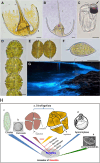
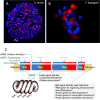
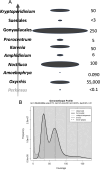



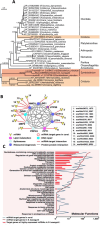

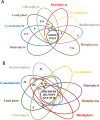
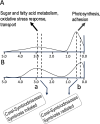
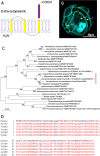
Similar articles
-
Genomes of the dinoflagellate Polarella glacialis encode tandemly repeated single-exon genes with adaptive functions.BMC Biol. 2020 May 24;18(1):56. doi: 10.1186/s12915-020-00782-8. BMC Biol. 2020. PMID: 32448240 Free PMC article.
-
The enigmatic nucleus of the marine dinoflagellate Prorocentrum cordatum.mSphere. 2023 Aug 24;8(4):e0003823. doi: 10.1128/msphere.00038-23. Epub 2023 Jun 26. mSphere. 2023. PMID: 37358287 Free PMC article.
-
Genomic understanding of dinoflagellates.Res Microbiol. 2011 Jul-Aug;162(6):551-69. doi: 10.1016/j.resmic.2011.04.006. Epub 2011 Apr 7. Res Microbiol. 2011. PMID: 21514379
-
Genome Evolution of Coral Reef Symbionts as Intracellular Residents.Trends Ecol Evol. 2019 Sep;34(9):799-806. doi: 10.1016/j.tree.2019.04.010. Epub 2019 May 10. Trends Ecol Evol. 2019. PMID: 31084944 Review.
-
Dinoflagellate genome evolution.Annu Rev Microbiol. 2011;65:369-87. doi: 10.1146/annurev-micro-090110-102841. Annu Rev Microbiol. 2011. PMID: 21682644 Review.
Cited by
-
Some Insights into the Inventiveness of Dinoflagellates: Coming Back to the Cell Biology of These Protists.Microorganisms. 2025 Apr 24;13(5):969. doi: 10.3390/microorganisms13050969. Microorganisms. 2025. PMID: 40431143 Free PMC article. Review.
-
Broad active metabolic pathways, autophagy, and antagonistic hormones regulate dinoflagellate cyst dormancy in marine sediments.Sci Adv. 2025 Feb 7;11(6):eads7789. doi: 10.1126/sciadv.ads7789. Epub 2025 Feb 7. Sci Adv. 2025. PMID: 39919173 Free PMC article.
-
Holocene and contemporary marine dinoflagellate community patterns predict expansion of generalist dinoflagellate blooms in warming oceans.ISME J. 2025 Jan 2;19(1):wraf095. doi: 10.1093/ismejo/wraf095. ISME J. 2025. PMID: 40367347 Free PMC article.
-
Positive Selection of a Starch Synthesis Gene and Phenotypic Differentiation of Starch Accumulation in Symbiotic and Free-Living Coral Symbiont Dinoflagellate Species.Genome Biol Evol. 2025 Jul 3;17(7):evaf133. doi: 10.1093/gbe/evaf133. Genome Biol Evol. 2025. PMID: 40599082 Free PMC article.
References
-
- Hackett JD, Anderson DM, Erdner DL, Bhattacharya D. Dinoflagellates: a remarkable evolutionary experiment. Am J Bot. 2004;91(10):1523–34. - PubMed
-
- Lin S. Genomic understanding of dinoflagellates. Res Microbiol. 2011;162(6):551–69. - PubMed
-
- Fensome RA. A classification of living and fossil dinoflagellates. Micropaleontology Spec Publ. 1993;7:351.
-
- Gómez F. A checklist and classification of living dinoflagellates (Dinoflagellata, Alveolata). Cicimar Oceánides. 2012;27(1):65–140.
-
- Logares R, Shalchian-Tabrizi K, Boltovskoy A, Rengefors K. Extensive dinoflagellate phylogenies indicate infrequent marine–freshwater transitions. Mol Phylogenet Evol. 2007;45(3):887–903. - PubMed
Publication types
MeSH terms
Grants and funding
LinkOut - more resources
Full Text Sources
Research Materials
Miscellaneous

